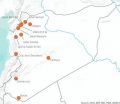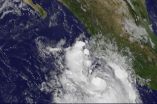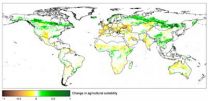(Press-News.org) SEPTEMBER 18 —In war-torn Syria, five of six World Heritage sites now "exhibit significant damage" and some structures have been "reduced to rubble," according to new high-resolution satellite image analysis by the nonprofit, nonpartisan American Association for the Advancement of Science (AAAS).
The AAAS analysis, offering the first comprehensive look at the extent of damage to Syria's priceless cultural heritage sites, was completed in partnership with the University of Pennsylvania Museum of Archaeology and Anthropology's Penn Cultural Heritage Center (PennCHC) and the Smithsonian Institution, and in cooperation with the Syrian Heritage Task Force. Funded by the National Science Foundation, the analysis provides authoritative confirmation of previous on-the-ground reports of damage to individual sites.
"Only one of Syria's six World Heritage sites—the Ancient City of Damascus—appears to remain undamaged in satellite imagery since the onset of civil war in 2011," said Susan Wolfinbarger, director of the Geospatial Technologies and Human Rights Project at AAAS. Historic structures at the other five sites, including ancient mosques, schools, and civilian as well as government buildings, have all been damaged and, in some cases, destroyed, AAAS reported. Wolfinbarger added, however, that "the Damascus site also could have damage not visible in satellite images."
AAAS released its analysis on the eve of a Smithsonian Institution meeting recognizing the 1954 Hague Convention for the Protection of Cultural Property in the Event of Armed Conflict. That event, organized in collaboration with the U.S. Committee of the Blue Shield and the Office of the Under Secretary for History, Art, and Culture, will take place 1:00-5:30 p.m. September 19 in the Ring Auditorium of the Hirshhorn Museum and Sculpture Garden, in Washington, D.C. (Some public seating will be available, on a limited basis.)
The AAAS analysis reveals extensive damage in Aleppo, one of the oldest continuously inhabited cities in the world, dating to the 2nd millennium B.C.: "In satellite imagery, massive destruction is obvious throughout the city, and especially at the World Heritage site of the Ancient City," Wolfinbarger said. Destroyed structures include historic mosques and madrasas (Koranic schools), the Great Mosque of Aleppo, the Suq al-Madina, the Grand Serail of Aleppo, the Hammam Yalbougha an-Nasry, the Khusruwiye Mosque, the Carlton Citadel Hotel, and the Khan Qurt Bey caravanserai, as well as other historic buildings south and north of the citadel.
Images captured in 2011 and 2014 revealed particularly severe damage to the Great Mosque, the nearby Suq al-Madina, and the surrounding area. AAAS and its partners documented roof damage and a destroyed minaret as well as two craters on the eastern wall of the mosque. While the heaviest damage was seen just south of the citadel, destruction was also evident to the north—an area with buildings from the late Mamluk to Ottoman periods (13th-19th centuries).
Across Syria's other World Heritage sites—the Ancient City of Bosra; the Ancient Site of Palmyra; the Ancient Villages of Northern Syria; and two castles, Crac des Chevaliers and Qal'at Salah El-Din—damage ranged from mortar impacts near an ancient Roman theater in Bosra, to military compounds in previously pristine archaeological sites, and new roads and earthen berms cut through the center of the Northern Roman Necropolis in Palmyra. UNESCO has said that Palmyra, located in the desert northeast of Damascus, "contains the monumental ruins of a great city that was one of the most important cultural centers of the ancient world," marrying Graeco-Roman art with Persian influences.
At the Crac des Chevaliers castle, one of the best-known examples of Crusader fortification architecture, images captured in 2010 and 2014 showed "moderate structural damage" such as a 6-meter gash to its southeast tower and cratering of the grounds, AAAS found. In the Jebel Barisha Ancient Village Park, one of Northern Syria's ancient villages, images captured before and after the onset of war revealed three new military compounds, two of which were within park boundaries.
"From our contacts and sources in Syria, we knew that there was damage to World Heritage sites," said Brian I. Daniels, Director of Research and Programs, Penn Cultural Heritage Center, University of Pennsylvania Museum, "but this report surprised us by revealing just how extensive the destruction actually is."
Corine Wegener, cultural heritage preservation officer for the Smithsonian Institution, said that organizing an international research community to study the primary causes of damage to cultural heritage in times of conflict will be critical to intervention efforts in Syria—a goal to be discussed at the September 19 meeting. "There is hope, and it lies with our Syrian colleagues because they are the stewards and caretakers of these sites, and they see the value in preserving and protecting them for future generations," Wegener said. "What they need from their international colleagues is some help to do that—training, materials, and other support in the international arena for the notion that it is possible to mitigate and prevent damage to cultural heritage, even in the midst of conflicts."
Continued AAAS research will further examine damage to Syria's World Heritage sites, as well as to many other sites of cultural significance, Wolfinbarger said. In 2013, all six of the sites were placed on the "List of World Heritage in Danger," maintained by UNESCO's World Heritage Center. The United Nations has estimated that the Syrian crisis has claimed 100,000 lives, and millions have been displaced.
Along with Wolfinbarger, Daniels, and Wegener, the research team included Richard M. Leventhal of the University of Pennsylvania; and Jonathan Drake, Eric Ashcroft, and Katharyn Hanson of AAAS. Images from the WorldView-1 and WorldView-2 satellites were provided by DigitalGlobe.
The AAAS Geospatial Technologies and Human Rights Project, part of the association's Scientific Responsibility, Human Rights and Law Program, had previously released reports on the conflict in Aleppo, which included an analysis of damage to the world heritage area there.
INFORMATION:
The American Association for the Advancement of Science (AAAS) is the world's largest general scientific society and publisher of the journal Science as well as Science Translational Medicine and Science Signaling. AAAS was founded in 1848 and includes some 261 affiliated societies and academies of science, serving 10 million individuals. Science has the largest paid circulation of any peer-reviewed general science journal in the world, with an estimated total readership of 1 million. The non-profit AAAS is open to all and fulfills its mission to "advance science and serve society" through initiatives in science policy, international programs, science education, public engagement, and more. For the latest research news, log onto EurekAlert!, the premier science-news Web site, a service of AAAS. See http://www.aaas.org.
REPORT — http://www.aaas.org/geotech/culturalheritage-SyrianWHS-92014.html
EVENT — http://uscbs.org/news/
New high-resolution satellite image analysis: 5 of 6 Syrian World Heritage sites 'exhibit significant damage'
2014-09-18
ELSE PRESS RELEASES FROM THIS DATE:
NASA marks Polo for a hurricane
2014-09-18
Hurricane Polo still appears rounded in imagery from NOAA's GOES-West satellite, but forecasters at the National Hurricane Center expect that to change.
NOAA's GOES-West satellite captured data on Hurricane Polo on Sept. 18 at 10:15 a.m. EDT. An image using that data was created by the NASA/NOAA GOES Project at NASA's Goddard Space Flight Center in Greenbelt, Maryland. The image showed thunderstorms wrapping tightly around the center of the storm while one broken band of thunderstorms extended to the northwest, while the other appeared on the eastern side of the center ...
New Dartmouth smartphone app reveals users' mental health, performance, behavior
2014-09-18
Dartmouth researchers and their colleagues have built the first smartphone app that automatically reveals students' mental health, academic performance and behavioral trends. In other words, your smartphone knows your state of mind -- even if you don't -- and how that affects you.
The StudentLife app, which compares students' happiness, stress, depression and loneliness to their academic performance, also may be used in the general population – for example, to monitor mental health, trigger intervention and improve productivity in workplace employees.
"The StudentLife ...
Fall foliage season may be later, but longer on warmer Earth
2014-09-18
The fall foliage season that prompts millions of Americans to undertake jaunts into the countryside each year could come much later and possibly last a little longer within a century, according to new research.
Climate change could postpone fall leaf peeping in some areas of the United States as summer temperatures linger later into the year, Princeton University researchers report in the journal Global Ecology and Biogeography. For instance, the paper birch — a popular foliage tree that is the state tree of New Hampshire — could change color one to three weeks later ...
Want to link genes to complex traits? Start with more diversity
2014-09-18
Life is rarely simple. From crop yields to disease risks, the biological characteristics people care most about are usually those considered "complex traits." Just as for height—the textbook example of a complex trait—attributes like risk for a particular human disease are shaped by multiple genetic and environmental influences, making it challenging to find the genes involved. To track down such genes, geneticists typically mate two individuals that differ in key ways—for example, a large mouse and a small mouse—and then study their descendents, looking for genes that ...
Americans rate losing eyesight as having greatest impact on their lives
2014-09-18
ALEXANDRIA, Va.—Sept. 18, 2014—Many Americans across racial and ethnic groups describe losing eyesight as potentially having the greatest impact on their day-to-day life, more so than other conditions including: loss of limb, memory, hearing and speech (57% of African-Americans, 49% of non-Hispanic whites, 43% of Asians and 38% of Hispanics). When asked which disease or ailment is the worst that could happen to them, blindness ranked first among African-Americans followed by AIDS/HIV. Hispanics and Asians ranked cancer first and blindness second, while Alzheimer's disease ...
Living in a disadvantaged neighborhood worsens musculoskeletal pain outcomes after trauma
2014-09-18
CHAPEL HILL, N.C. – Individuals living in disadvantaged neighborhoods have worse musculoskeletal pain outcomes over time after stressful events such as motor vehicle collision than individuals from higher socioeconomic status neighborhoods, even after accounting for individual characteristics such as age, sex, income, education, and employment status.
These were the findings of a multi-site research study led by Samuel McLean, MD, MPH, associate professor of anesthesiology and emergency medicine at the University of North Carolina School of Medicine. The results of the ...
Global agriculture: More land, fewer harvests
2014-09-18
According to a simulation of the impact of climate change on agricultural production over the course of the 21st century, carried out by researchers led by Professor Wolfram Mauser at LMU's Department of Geography, some two-thirds of all land potentially suitable for agricultural use is already under cultivation. The study indicates that climate change will expand the supply of cropland in the high latitudes of the Northern hemisphere (Canada, Russia, China) over the next 100 years. However, in the absence of adaptation measures such as increased irrigation, the simulation ...
Withdrawal from the evolutionary race
2014-09-18
This news release is available in German. In ecology, disease tolerance is defined as a host strategy not to fight a pathogen tooth and nail, but rather tolerate it to live (and survive) better in the long term. One key feature of tolerance is that the disease only progresses very slowly – if at all – even if the host carries a high pathogen load.
Roland Regoes, a senior scientist at ETH Zurich's Institute of Theoretical Biology, has now transferred this approach to HIV. He set about investigating whether there are infected people who are more tolerant of the HI virus ...
Decision-support program helps keep seniors out of the emergency room
2014-09-18
New Rochelle, NY, September 18, 2014–An Emergency Room Decision-Support (ERDS) program can significantly reduce ER visits and hospital admissions among older adults on Medicare. This could have important economic implications, helping to reduce the nearly 33% of avoidable ER visits that contribute to about $18 billion in unnecessary healthcare costs each year. Details of a successful ERDS program that had a positive return on investment are published in an article in Population Health Management, a peer-reviewed journal from Mary Ann Liebert, Inc., publishers. The article ...
Language evolution: Quicker on the uptake
2014-09-18
The ability to acquire and creatively manipulate spoken language is unique to humans. "The genetic changes that occurred over the past 6 million years of human evolution to make this possible are largely unknown, but Foxp2 is the best candidate gene we now have," says Wolfgang Enard, Professor of Anthropology and Human Biology at LMU. In his efforts to understand the molecular biological basis of language Enard has now taken an important step forward. The results of his latest study, undertaken in collaboration with scientists at several universities, including the Massachusetts ...







